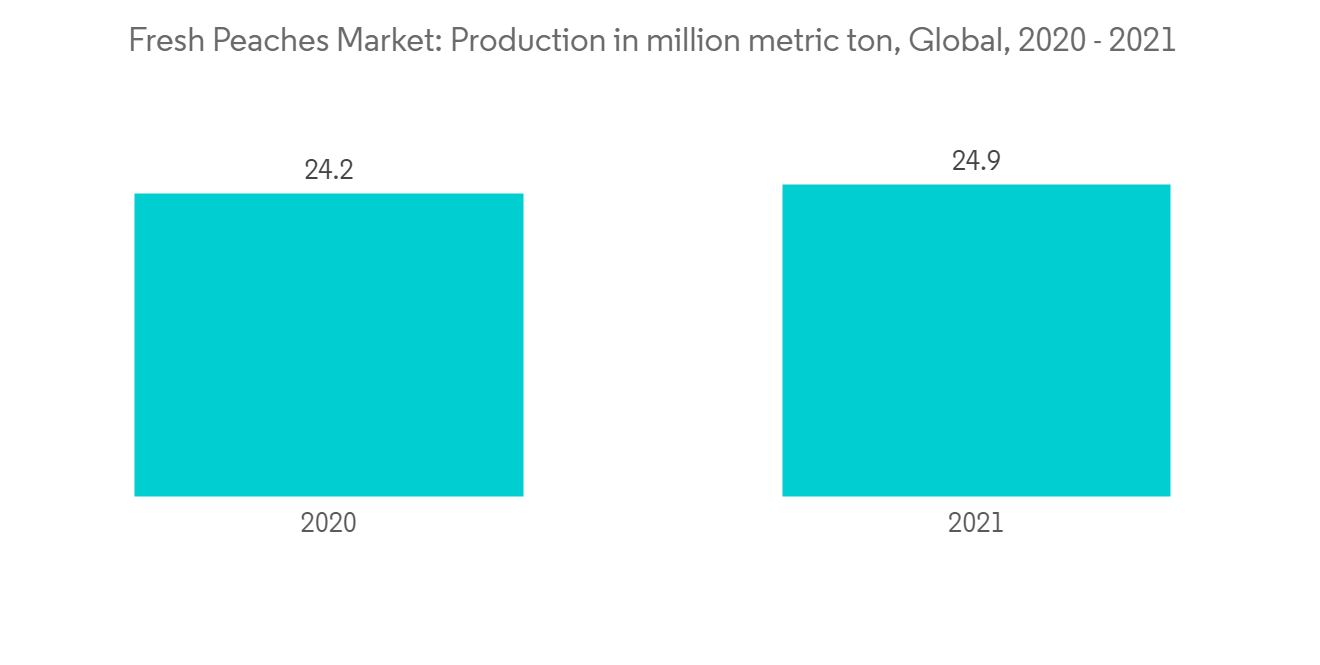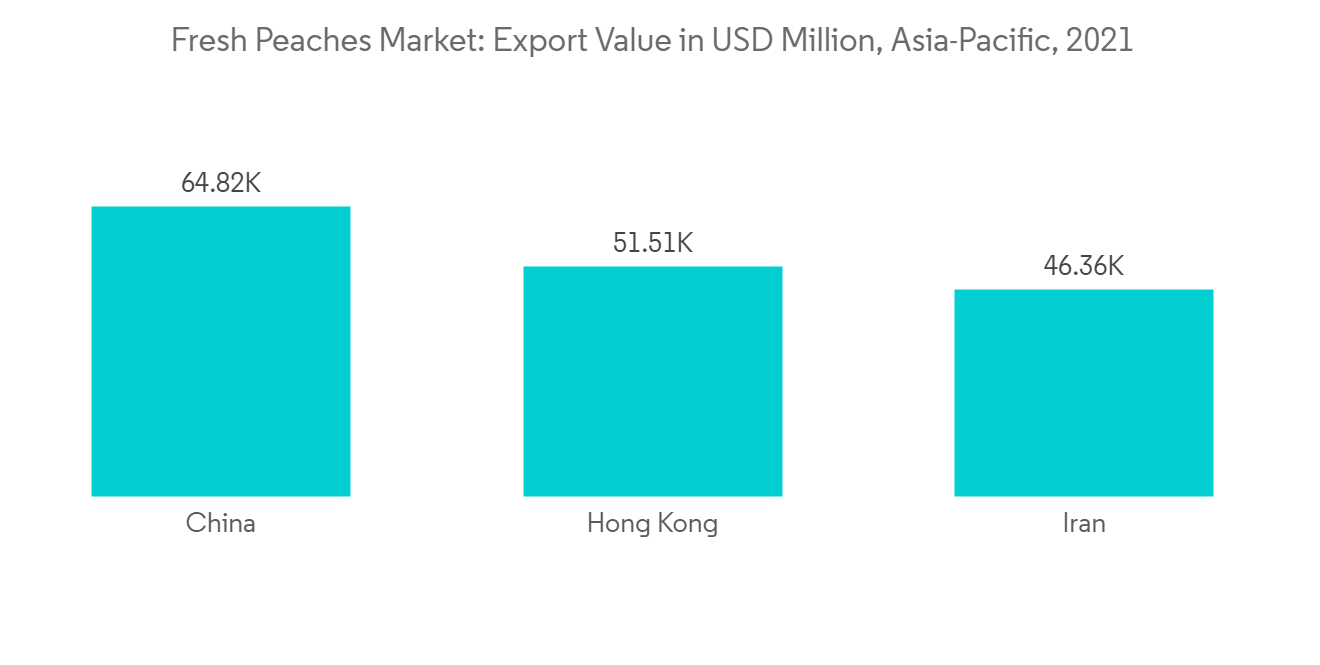 |
市場調查報告書
商品編碼
1273337
新鮮桃子市場 - 增長、趨勢、COVID-19 的影響和預測 (2023-2028)Fresh Peaches Market - Growth, Trends, and Forecasts (2023 - 2028) |
||||||
※ 本網頁內容可能與最新版本有所差異。詳細情況請與我們聯繫。
在預測期內,全球鮮桃市場預計將以 3.2% 的複合年增長率增長。
主要亮點
- 新鮮桃子對健康有很多好處,包括增強免疫力、改善消化、控制血壓和降低患慢性病的風險。 黃肉桃在美國很常見,而白肉桃在亞洲國家很常見。
- 中國北京的網購和專業團隊教農民在手機上銷售自己的桃子,將當地的桃子產業轉變為現代化的互聯網+業務,並越來越受歡迎。 到 2021 年,平創的電商桃子銷量將達到 2500 萬公斤,而 2012 年幾乎為零。 桃子的線上需求也帶動了順豐、中國郵政等當地物流業的發展。 在政府的支持下,平溪開始打造農業創新中心,重點發展現代種業、生物技術、智慧農業和食品安全。 這可能會在未來幾年進一步推動市場增長。
- 生產商還採用高種植密度,使用新品種和砧木,並實施現代樹木培訓系統。 這些變化也推動了政府補貼燃料、肥料和幼苗等各種成本的計劃,以增加桃子產量,加強市場。
鮮桃市場趨勢
桃子的健康益處將推動生桃市場的增長。
桃子的營養價值很高,包括膳食纖維、低糖分、維生素(A、C、E、菸酸)以及鉀、銅、錳和磷等礦物質,預計對健康有多種益處. 因此,桃子育種者計劃開發具有改善口味和健康益處的品種。
健康生活方式意識的提高正在推動新鮮水果消費量的增加,從而推動新鮮桃子市場的發展。 隨著人們關注健身和營養,他們越來越了解所吃食物中的卡路裡數量。 桃子在包括中國、西班牙、土耳其和美國在內的多個國家進行商業生產,並以新鮮和加工的方式出售。 截至 2021 年,全球桃子總產量為 2490 萬噸。 這些因素越來越有助於市場的增長。
中國是越南桃子和油桃的主要供應國。 澳大利亞和越南之間的一項新協議允許澳大利亞桃子和油桃出口商進入越南市場。 預計這將進一步推動對進口水果的需求,尤其是越南年輕和富裕消費者的需求。 這些消費者願意為進口食品支付更高的價格,尤其是清潔、綠色、天然、健康和增強免疫力的產品。 現代零售渠道,特別是超市和便利店的增長,以及向電子商務的快速轉變,支持了消費者在水果上的支出。

亞太地區是鮮桃市場的主要參與者
亞太地區是世界上最大且增長最快的市場。 該地區早年大部分地區的生長條件良好,因此單產很高。 中國是該地區的主要生產國,佔鮮桃市場總量的 61.4%。 據ITC Trade稱,2021年桃子出口額將達到6482.1萬美元,比上年略有增長。
中國是世界上最大的桃子生產國,其次是西班牙、意大利和美國。 據美國農業部稱,隨著中國從雪災造成的農作物損失中恢復過來,桃子產量預計到 2022 年將達到 2180 萬噸。 預計將從100萬噸增加到1600萬噸。 新鮮桃子提供的特殊益處使這種水果成為心臟健康飲食的重要組成部分,這極大地推動了市場的增長。
此外,政府放寬土地流轉政策,鼓勵許多個人和私營公司通過土地整理投資桃子的規模化生產。 然而,冷鏈存儲的高成本和檢疫要求阻礙了進口商。 因此,已經開發出更多耐貯藏桃品種以滿足市場需求,並且在預測期內市場可能會擴大。

其他福利:
- Excel 格式的市場預測 (ME) 表
- 三個月的分析師支持
內容
第一章介紹
- 研究假設和市場定義
- 本次調查的範圍
第二章研究方法論
第 3 章執行摘要
第四章市場動態
- 市場概覽
- 市場驅動力
- 市場製約因素
- 價值鏈/供應鏈分析
第 5 章市場細分
- 地區
- 北美
- 美國
- 生產分析
- 消費市場分析(數量和價值)
- 進口市場分析(數量和價值)
- 出口市場分析(數量和價值)
- 價格趨勢分析
- 加拿大
- 生產分析
- 消費分析(數量和價值)
- 進口市場分析(數量和價值)
- 出口市場分析(數量和價值)
- 價格趨勢分析
- 墨西哥
- 生產分析
- 消費分析(數量和價值)
- 進口市場分析(數量和價值)
- 出口市場分析(數量和價值)
- 價格趨勢分析
- 歐洲
- 德國
- 生產分析
- 消費市場分析(數量和價值)
- 進口市場分析(數量和價值)
- 出口市場分析(數量和價值)
- 價格趨勢分析
- 波蘭
- 生產分析
- 消費分析(數量和價值)
- 進口市場分析(數量和價值)
- 出口市場分析(數量和價值)
- 價格趨勢分析
- 意大利
- 生產分析
- 消費分析(數量和價值)
- 進口市場分析(數量和價值)
- 出口市場分析(數量和價值)
- 價格趨勢分析
- 法國
- 生產分析
- 消費分析(數量和價值)
- 進口市場分析(數量和價值)
- 出口市場分析(數量和價值)
- 價格趨勢分析
- 土耳其人
- 生產分析
- 消費市場分析(數量和價值)
- 進口市場分析(數量和價值)
- 出口市場分析(數量和價值)
- 價格趨勢分析
- 亞太地區
- 中國
- 生產分析
- 消費市場分析(數量和價值)
- 進口市場分析(數量和價值)
- 出口市場分析(數量和價值)
- 價格趨勢分析
- 韓國
- 生產分析
- 消費市場分析(數量和價值)
- 進口市場分析(數量和價值)
- 出口市場分析(數量和價值)
- 價格趨勢分析
- 日本
- 生產分析
- 消費分析(數量和價值)
- 進口市場分析(數量和價值)
- 出口市場分析(數量和價值)
- 價格趨勢分析
- 印度
- 生產分析
- 消費市場分析(數量和價值)
- 進口市場分析(數量和價值)
- 出口市場分析(數量和價值)
- 價格趨勢分析
- 南美洲
- 巴西
- 生產分析
- 消費市場分析(數量和價值)
- 進口市場分析(數量和價值)
- 出口市場分析(數量和價值)
- 價格趨勢分析
- 阿根廷
- 生產分析
- 消費分析(數量和價值)
- 進口市場分析(數量和價值)
- 出口市場分析(數量和價值)
- 價格趨勢分析
- 智利
- 生產分析
- 消費分析(數量和價值)
- 進口市場分析(數量和價值)
- 出口市場分析(數量和價值)
- 價格趨勢分析
- 非洲
- 南非
- 生產分析
- 消費市場分析(數量和價值)
- 進口市場分析(數量和價值)
- 出口市場分析(數量和價值)
- 價格趨勢分析
- 埃及
- 生產分析
- 消費分析(數量和價值)
- 進口市場分析(數量和價值)
- 出口市場分析(數量和價值)
- 價格趨勢分析
- 北美
第六章市場機會與未來趨勢
The global fresh peaches market is projected to grow at a CAGR of 3.2% during the forecast period.
Key Highlights
- Fresh peaches exhibit multiple potential health benefits, such as a strong immune system, improved digestion, control of blood pressure, and decreases the risk of chronic diseases. The yellow-fleshed peaches are commonly found in the United States, were as white-fleshed are common in Asian countries.
- As online shopping has become increasingly popular in Beijing's, China and professional team was set up to teach farmers to sell their peaches with mobile phones and transform the local peach industry into a modernized internet-plus business. Peach sales via e-commerce across Pinggu stood at 25 million kg in 2021, compared with nearly zero in 2012. The online demand for peaches has also boosted the development of the local logistics industry such as SF Express and China Post. With government support, Pinggu started building itself into an agricultural innovation hub focusing on the modern seed industry, biotechnology, smart farming, and food safety. This can further boost the market to grow in coming years.
- Growers have also adopted the practice of high-density plantings, used new cultivars and rootstocks, and installed modern tree-training systems. These changes have been in part propelled by government programs that provide support for various costs including for fuel, fertilizer, and saplings to increase the production of peaches in order to strengthen the market.
Fresh Peaches Market Trends
Significant health benefits of peaches is promoting the growth of fresh peaches market
Peaches have various health benefits as they comprise nutritive elements such as dietary fibers, low carbohydrates, vitamins(A, C, E, and niacin), and also minerals, such as potassium, copper, manganese, and phosphorous. Therefore, peach breeders are planning to develop varieties with improved eating quality and health benefits.
The growing awareness of a healthy lifestyle is propelling the increased consumption of fresh fruits, which is in turn driving the fresh peach market. People are gaining more knowledge about the number of calories present in the food they consume, in order to focus more on fitness, and nutrition. Peaches are commercially produced in various countries like China, Spain, Turkey, & the United States and are marketed in both fresh and processed forms. As of 2021, the volume of total global production of peaches was 24.9 million tons. These factors are increasingly contributing to the growth of the market.
China is the predominant supplier of peaches and nectarines to Vietnam. Australian peach and nectarine exporters now have market access to Vietnam this comes after Australia and Vietnam finalised a new protocol. This will fuel further growth in demand for imported fruits, driven by Vietnam's young, increasingly wealthy consumers. These consumers are willing to pay more for imported food, particularly naturally healthy, immune-boosting products with clean and green credentials.Growth in modern retail channels, particularly supermarkets and convenience stores, and a rapid shift to e-commerce will support consumer expenditure on fruit.

Asia Pacific is the key player in the Fresh Peaches Market
Asia-Pacific is the largest and fastest growing market globally. The region is supported by favourable growing conditions in the majority of the places during the early season, hence the harvest recorded is of high volume. China is the leading producer in this region which accounts for 61.4% of the total fresh peach market. According to ITC Trade, the export value of peaches has increased to USD 64,821 Thousand in 2021 which slightly increased compare to previous year in the China.
China is the world's leading producer of peaches, followed by Spain, Italy, and the United States. According to the USDA, peach production is expected to reach 21.8 million metric ton in 2022, as China has recovered from the snow-damaged crop losses. It is anticipated to increase from 1.0 million ton to 16.0 million ton. The special benefits offered by fresh peaches have made this fruit an important part of a heart-healthy diet, which is largely driving the growth of the market.
The relaxed government policies on land transfers, have further encouraged many individuals and private companies to invest in large-scale production of peach through land consolidation. However, high costs and quarantine requirements for cold-chain storage is detering the importers. Therefore, peache varieties with longer shelf-life are being developed to meet the market requirements and tends to grow market during the forecasting period.

Additional Benefits:
- The market estimate (ME) sheet in Excel format
- 3 months of analyst support
TABLE OF CONTENTS
1 INTRODUCTION
- 1.1 Study Assumptions and Market Definitions
- 1.2 Scope of the Study
2 RESEARCH METHODOLOGY
3 EXECUTIVE SUMMARY
4 MARKET DYNAMICS
- 4.1 Market Overview
- 4.2 Market Drivers
- 4.3 Market Restraints
- 4.4 Value Chain / Supply Chain Analysis
5 MARKET SEGMENTATION
- 5.1 Geography
- 5.1.1 North America
- 5.1.1.1 United States
- 5.1.1.1.1 Production Analysis
- 5.1.1.1.2 Consumption Analysis (Volume and Value)
- 5.1.1.1.3 Import Market Analysis (Volume and Value)
- 5.1.1.1.4 Export Market Analysis (Volume and Value)
- 5.1.1.1.5 Price Trend Analysis
- 5.1.1.2 Canada
- 5.1.1.2.1 Production Analysis
- 5.1.1.2.2 Consumption Analysis (Volume and Value)
- 5.1.1.2.3 Import Market Analysis (Volume and Value)
- 5.1.1.2.4 Export Market Analysis (Volume and Value)
- 5.1.1.2.5 Price Trend Analysis
- 5.1.1.3 Mexico
- 5.1.1.3.1 Production Analysis
- 5.1.1.3.2 Consumption Analysis (Volume and Value)
- 5.1.1.3.3 Import Market Analysis (Volume and Value)
- 5.1.1.3.4 Export Market Analysis (Volume and Value)
- 5.1.1.3.5 Price Trend Analysis
- 5.1.2 Europe
- 5.1.2.1 Germany
- 5.1.2.1.1 Production Analysis
- 5.1.2.1.2 Consumption Analysis (Volume and Value)
- 5.1.2.1.3 Import Market Analysis (Volume and Value)
- 5.1.2.1.4 Export Market Analysis (Volume and Value)
- 5.1.2.1.5 Price Trend Analysis
- 5.1.2.2 Poland
- 5.1.2.2.1 Production Analysis
- 5.1.2.2.2 Consumption Analysis (Volume and Value)
- 5.1.2.2.3 Import Market Analysis (Volume and Value)
- 5.1.2.2.4 Export Market Analysis (Volume and Value)
- 5.1.2.2.5 Price Trend Analysis
- 5.1.2.3 Italy
- 5.1.2.3.1 Production Analysis
- 5.1.2.3.2 Consumption Analysis (Volume and Value)
- 5.1.2.3.3 Import Market Analysis (Volume and Value)
- 5.1.2.3.4 Export Market Analysis (Volume and Value)
- 5.1.2.3.5 Price Trend Analysis
- 5.1.2.4 France
- 5.1.2.4.1 Production Analysis
- 5.1.2.4.2 Consumption Analysis (Volume and Value)
- 5.1.2.4.3 Import Market Analysis (Volume and Value)
- 5.1.2.4.4 Export Market Analysis (Volume and Value)
- 5.1.2.4.5 Price Trend Analysis
- 5.1.2.5 Turkey
- 5.1.2.5.1 Production Analysis
- 5.1.2.5.2 Consumption Analysis (Volume and Value)
- 5.1.2.5.3 Import Market Analysis (Volume and Value)
- 5.1.2.5.4 Export Market Analysis (Volume and Value)
- 5.1.2.5.5 Price Trend Analysis
- 5.1.3 Asia-Pacific
- 5.1.3.1 China
- 5.1.3.1.1 Production Analysis
- 5.1.3.1.2 Consumption Analysis (Volume and Value)
- 5.1.3.1.3 Import Market Analysis (Volume and Value)
- 5.1.3.1.4 Export Market Analysis (Volume and Value)
- 5.1.3.1.5 Price Trend Analysis
- 5.1.3.2 South Korea
- 5.1.3.2.1 Production Analysis
- 5.1.3.2.2 Consumption Analysis (Volume and Value)
- 5.1.3.2.3 Import Market Analysis (Volume and Value)
- 5.1.3.2.4 Export Market Analysis (Volume and Value)
- 5.1.3.2.5 Price Trend Analysis
- 5.1.3.3 Japan
- 5.1.3.3.1 Production Analysis
- 5.1.3.3.2 Consumption Analysis (Volume and Value)
- 5.1.3.3.3 Import Market Analysis (Volume and Value)
- 5.1.3.3.4 Export Market Analysis (Volume and Value)
- 5.1.3.3.5 Price Trend Analysis
- 5.1.3.4 India
- 5.1.3.4.1 Production Analysis
- 5.1.3.4.2 Consumption Analysis (Volume and Value)
- 5.1.3.4.3 Import Market Analysis (Volume and Value)
- 5.1.3.4.4 Export Market Analysis (Volume and Value)
- 5.1.3.4.5 Price Trend Analysis
- 5.1.4 South America
- 5.1.4.1 Brazil
- 5.1.4.1.1 Production Analysis
- 5.1.4.1.2 Consumption Analysis (Volume and Value)
- 5.1.4.1.3 Import Market Analysis (Volume and Value)
- 5.1.4.1.4 Export Market Analysis (Volume and Value)
- 5.1.4.1.5 Price Trend Analysis
- 5.1.4.2 Argentina
- 5.1.4.2.1 Production Analysis
- 5.1.4.2.2 Consumption Analysis (Volume and Value)
- 5.1.4.2.3 Import Market Analysis (Volume and Value)
- 5.1.4.2.4 Export Market Analysis (Volume and Value)
- 5.1.4.2.5 Price Trend Analysis
- 5.1.4.3 Chile
- 5.1.4.3.1 Production Analysis
- 5.1.4.3.2 Consumption Analysis (Volume and Value)
- 5.1.4.3.3 Import Market Analysis (Volume and Value)
- 5.1.4.3.4 Export Market Analysis (Volume and Value)
- 5.1.4.3.5 Price Trend Analysis
- 5.1.5 Africa
- 5.1.5.1 South Africa
- 5.1.5.1.1 Production Analysis
- 5.1.5.1.2 Consumption Analysis (Volume and Value)
- 5.1.5.1.3 Import Market Analysis (Volume and Value)
- 5.1.5.1.4 Export Market Analysis (Volume and Value)
- 5.1.5.1.5 Price Trend Analysis
- 5.1.5.2 Egypt
- 5.1.5.2.1 Production Analysis
- 5.1.5.2.2 Consumption Analysis (Volume and Value)
- 5.1.5.2.3 Import Market Analysis (Volume and Value)
- 5.1.5.2.4 Export Market Analysis (Volume and Value)
- 5.1.5.2.5 Price Trend Analysis
- 5.1.1 North America





